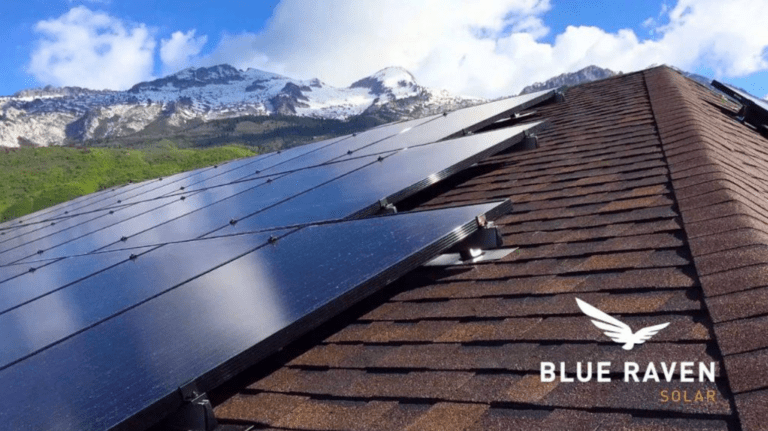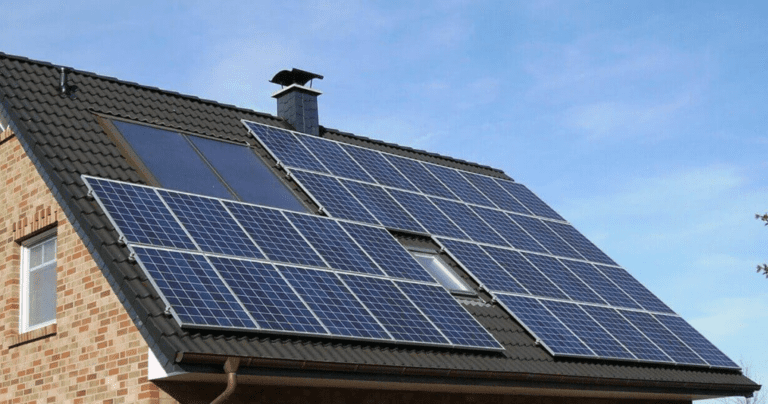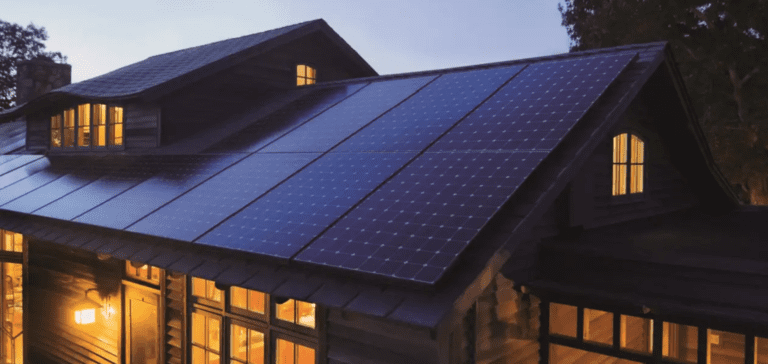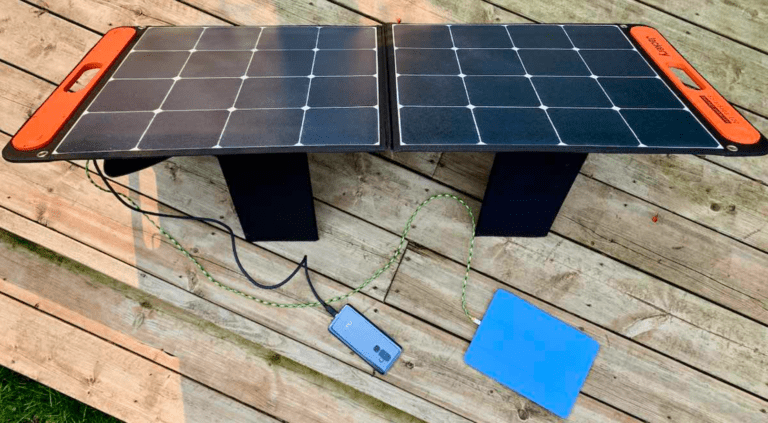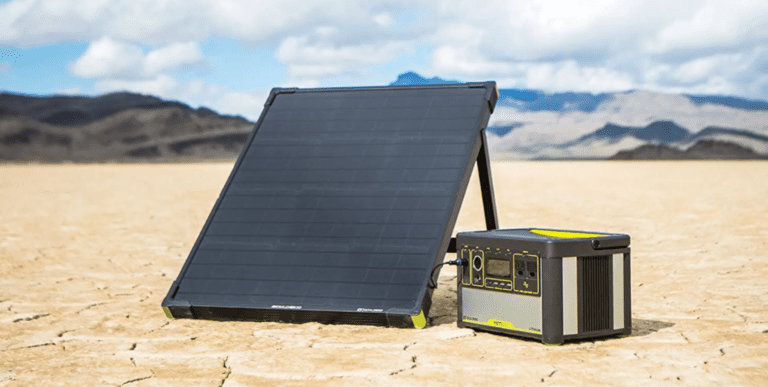Review about Solar panel with charge system
Electronics are part of the adventure of tools more than ever. Thanks to efficiency advances and cost reductions in solar cells, portable solar chargers are finally proving to be a viable means of powering the outdoors. A backcountry user can carry smartphones, GoPros, headlamps, tablets, cameras, headphones, and PLB or GPS devices. A family going on an extended weekend trip will likely bring multiple smartphones, tablets, speakers, laptops, electric lanterns, and more. Rafters, climbers, backpackers, and mountain bikers can take out even more high-powered lights and GoPros, radios, and other electronic devices on weekend missions.
By harnessing the sun’s energy, one can charge their legions of devices instead of carrying physical batteries or draining the battery in their car or camper. From portable solar chargers that can accommodate multiple devices during a family camping trip, to ultra-chargeable power banks, to lightweight options for backcountry users that weigh less than a pound. , we reviewed the top models to find the best portable solar chargers for the outdoors. . Also, we have tips and tricks on how to get the most out of your portable solar panels, power banks, and chargers.
We create, with reader input, objective gear reviews that are independently selected by our editors. This story may contain affiliate links, which help fund our website. When you click on links to purchase gear, we may receive a commission, at no additional cost to you.
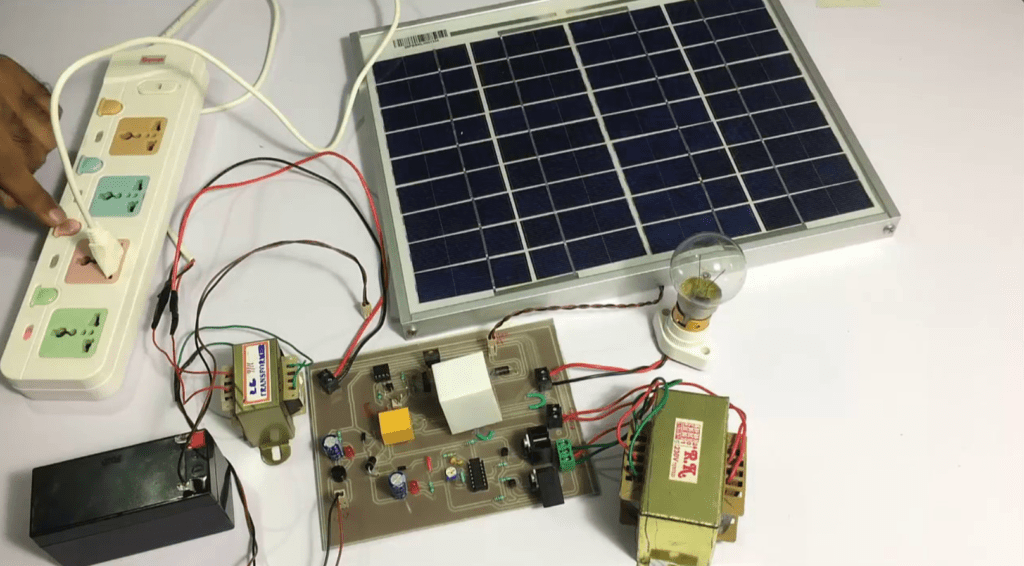
COMPARE PORTABLE SOLAR CHARGERS ON A TABLE
| Solar Charger | Award | Weight | Foldable | Solar Cell Output Capacity | Power Output to Device | Integrated Battery |
| Big Blue 28W USB Solar Charger | Best Overall Solar Charger | 1 pound, 5 ounces | Yes | 28W | USB, 5V up to 2A (28W max) | No |
| Goal Zero Nomad 50 | Best for Camping and Basecamping, Best Upgrade Solar Charger | 6 pounds | Yes | 50W | USB, 5V up to 2.4A (12W max)/8mm: 14-22V, up to 3.5A (50W Max) | Goal Zero Sherpa 100 AC sold separetely |
| BioLite SolarPanel 10+ | Best Solar Charger with Integrated Battery | 1 pound, 3.4 ounces | Yes | 10W | use integrated battery | Yes, Battery Storage Capacity (mAH): 3,200 milliamp hours |
| Anker 21 Watt PowerPort Solar Charger | 14.7 ounces | Yes | 21W | USB, 21W | No | |
| Nekteck 28 Watt Solar Charger | 1.44 pounds | Yes | 28W | USB, 28 W | No | |
| BioLite SolarPanel 5+ | 13.76 ounces | Yes | 5W | use integrated battery | Yes, Battery storage capacity 3200mAh Li-on, 8 Wh | |
| Goal Zero Nomad 10 | 1.2 pounds | Yes | 10W | 6-7V | Goal Zero Sherpa 15 AC sold separately | |
| Goal Zero Nomad 100 | 10.2 pounds | Yes | 100W | Solar Port (blue 8mm, male): 14-22V, up to 5.56A (100 max) | Goal Zero Yeti is sold separately |
Best Portable Solar Chargers
We had three clones to test, all of which performed similarly well, so it was hard to decide which one to give the award to. However, one surpassed the others, as mentioned by various sites. We also considered various use cases in making our final decisions. As such, some of our winners are in unique categories.
- Large Blue 28W USB Solar Charger
- Overall Winner: Big Blue 28W USB Solar Charger
- Weight: 1 pound, 5 ounces
Solar cell output capacity: 10 watts
Power output to device: USB, up to 5V 2A (28W max)
Foldable: Yes
We agree with many review sites and user reviews that the 1 pound, 5 ounce Big Blue 28W USB Solar Charger was perfect for most outdoor use. It is a simple, lightweight, and powerful solar charger that delivers slightly more power than its competition. It will also provide enough power for one or two people to charge multiple small devices in direct sunlight.
The Big Blue unit we tested also included an ammeter, which shows the amount of electric current generated by the solar panel, which sets it apart from the competition. This allowed us to see how the device was performing like the LED lights on every other solar charger we tested and how much energy it was producing.
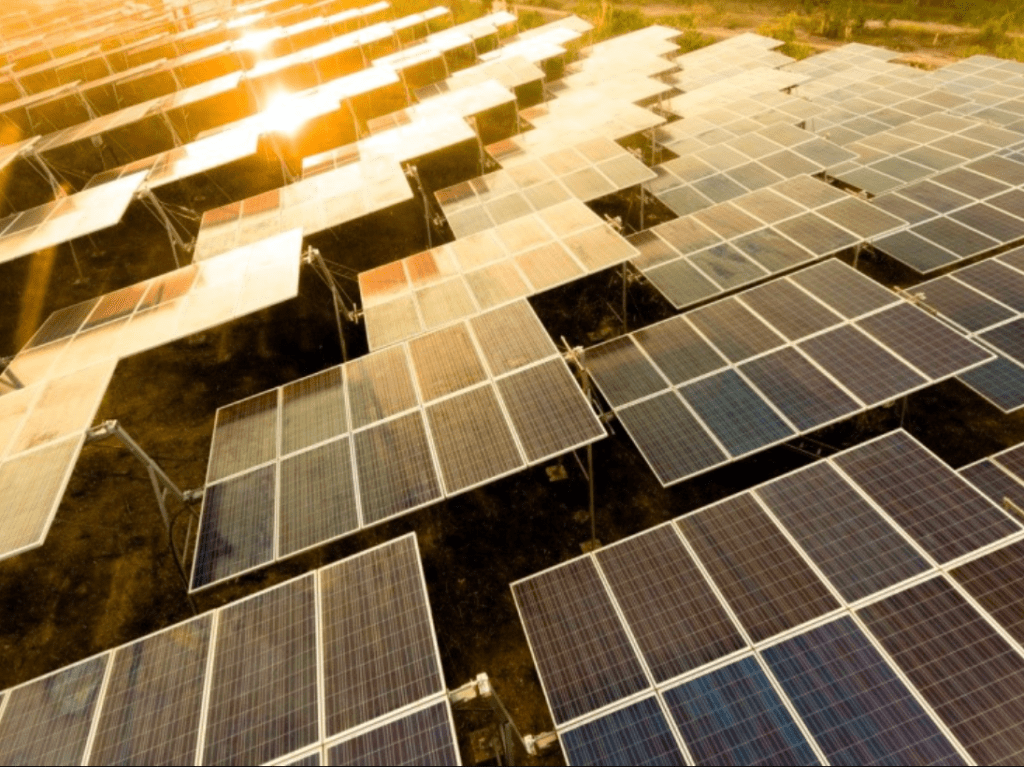
- Charging the solar panel on the back of the bag to provide energy for the overhead headlamp
- Charging the solar panel on the back of the bag to provide energy for the overhead headlamps.
Other than that, we found it to be remarkably, if not amazingly, similar to two other top-rated solar chargers we reviewed. All three
- the Anker 21-Watt Powerport Solar Charger,
- the Nectech 28-Watt Solar Charger,
- the Big Blue 28W USB Solar Charger
use the same basic design with two USB ports and a light to indicate that they’re charging. They are receiving a charge. Big Blue’s light indicator is the emitter.
The solar cells in these foldable units are encased in PET polymer and surrounded by polyester canvas. Each offers a modest IPX4 water resistance—though you really don’t want to use these devices in the rain. They are so similar that they even use the same solar cells – SunPower’s Maxion solar cells – which are among the most efficient commercially available solar cells and can convert up to 25 percent of the sun’s energy.
Each of these solar chargers had metal grommets in the casing, allowing you to attach them to a rock, backpack, tent, or camp chair. Each has a pouch where you can store the device being charged and the cords to charge your devices. No one had a kickstand or the means to properly direct them to the sun, so you had to get a little more creative, like standing them on a rock, attaching them to your tent, or using your Pairing with bags to orient them correctly. Power up as many of them as you can in the camp.
Big Blue outperformed the competition in tests, producing just under 950 milliamp-hours (mAh) of energy per hour. Under relatively similar conditions, the Anker produced 733 mAh, and the Nectech produced 834 mAh. Without a dedicated test facility and control environment, it is difficult to provide a full scientific evaluation of the differences between the three because clouds may have obscured the sun for part of the test periods.
In our experience, Big Blue (or similar solar panels) will integrate best into your outdoor lifestyle with the help of an external battery, such as an anchor. The solar panel charges the battery, and then the battery provides a constant charge to reliably and safely charge your phone. See our section below on batteries for more details.
The Big Blue offered the highest power output of the three, and it’s basically the same price as the Nectech, so the Big Blue edged out the Nectech as the best solar charger. It’s easy to use, a good value and offers enough portable power to charge a backup battery. Best yet, it’s rugged enough to last for years.
- PCT gear list and strategy
- Best sleeping bag for backpacking
- The best sleeping pad for backpacking
- Best Backpacking Tents
- Best lightweight hiking boots
The Round Zero Nomad 50 Solar Panel is the best solar panel for camping and base camping
Best Upgraded Solar Charger: Round Zero NOMAD 50
Best Solar Charger for Camping: Round Zero NOMAD 50
Best Solar Charger for Basecamping: Round Zero NOMAD 50
Weight: 6 pounds
Solar cell output capacity: 50 watts
Power output in device: USB: 5V up to 2.4A (12W max)/8mm: 14-22V, up to 3.5A (50W max)
Foldable: Yes
The Goal Zero Nomad 50 is a large solar charger that is the best solar charger for car camping and the best solar charger for base camping.
Mid-level solar controllers up to 40A
Small capacity MPPT solar charge controllers with current ratings from 20A to 40A are used for many different applications including off-grid cabins and homes, RV’s, boats, caravans, telecommunications, and remote site backup. These mid-range MPPT solar charge controllers are available from many different manufacturers, but this review will focus on the most popular and best quality charge controllers that have been on the market for many years.
Standard of comparison
In this review, we rank different charge controllers according to several key criteria including build quality, MPPT tracking speed, battery voltage range, operating temperature range (heat dissipation), monitoring, real-world performance and price. . In our reviews, we usually rate performance and quality over affordability, so in this case, we rate unit price lower than other criteria. This may come across as a bias towards more expensive models, but based on real-world results, testing and performance monitoring, high-end controllers have proven to outperform cheaper models.
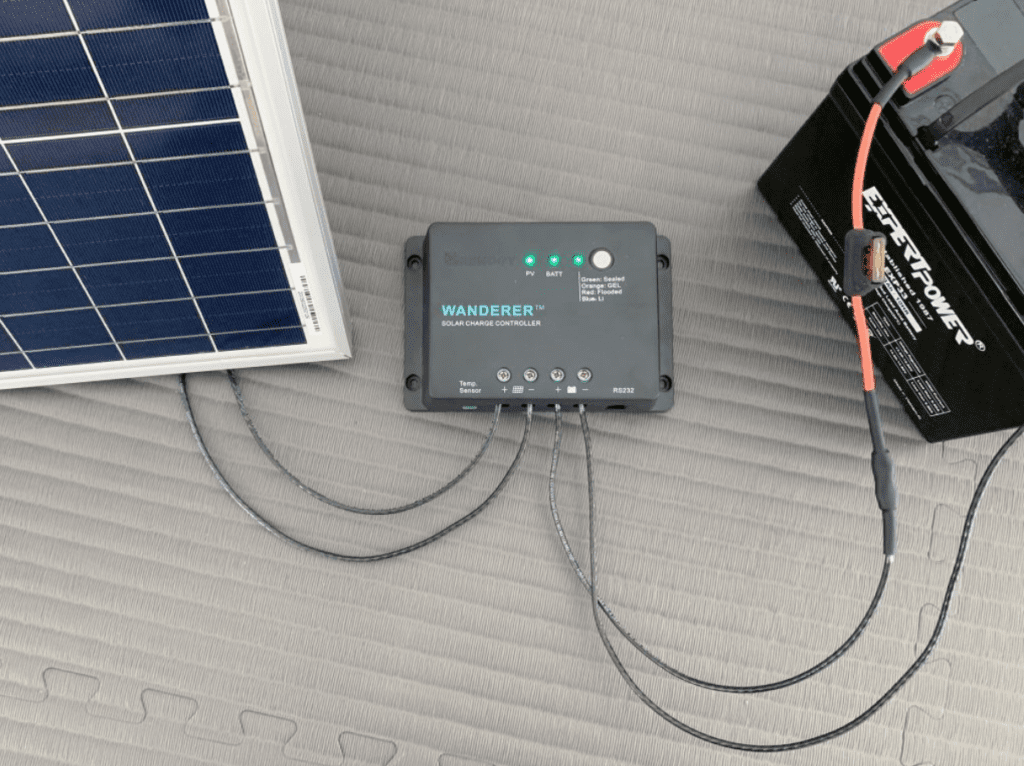
- Build quality
- MPP Tracking
- PV voltage range
- Battery voltage options
- Monitoring
- Price / Price
- Configuration options
1. Victron Smart Solar
Victron Energy is considered a world leader in power electronics and specializes in the manufacture of equipment required for off-grid and stand-alone power systems including inverters, batteries, chargers, monitors and of course solar charge controllers. Based in the Netherlands, Victron manufactures many products in India and is known for its wide range of quality, reliable off-grid battery inverters/chargers and standard MPPT solar charge controllers.
Victron offers a large range of solar charge controllers, from small 10A PWM models to high efficiency 100A MPPT types with high voltage inputs up to 250V. The MPPT 150V models appear very simple in design, and may not have displays or load control terminals like many others, however, where Victron out competes is in MPPT tracking performance, communication and monitoring. Is.
Victron has the most advanced monitoring system ever with a Bluetooth connection that offers easy programming and configuration, as well as remote firmware updates that add additional features and options. The display-less design may not please all users, but the fast, accurate MPPT tracking, high build quality, and V.E. Smart networking options are standout features.
Smartsolar MPPT 150V 35A
Advantages:
- Faster MPP tracking
- 150V max Voc
- 12V, 24V or 48V batteries
- Compatible with LiFePO4 lithium batteries
- Very advanced monitoring app
- Wide operating temperature up to 60°C
- Built-in temperature sensor
- Optional wireless battery sensor
Cons:
- No display.
- There is no load control.
- Expensive $$$
2. Ever-Terrone Series
EPever was founded in 2007 and has grown rapidly to become one of the largest Chinese manufacturers of affordable power products including a wide range of MPPT solar charge controllers. The Triron series is the next evolution of MPPT’s popular Tracer series.
The TRIRON series from EPever is a much more advanced and user-friendly version of the original AN series charge controllers. TRIRON controllers have a unique replaceable display module as well as a replaceable interface module with an RS485 communication option that can be used for a number of different applications. Note, the maximum PV voltage is either 100V or 150V depending on the model. The 5 button display module is very easy to use and provides all the important information you need about PV, battery and load. Wireless access is available via the eBox-BLE Bluetooth adapter or a Wifi adapter is available for remote monitoring.
TRIRON Series MPPT 150V 40A
Advantages:
- Faster MPP tracking
- 150V Maximum Voltage Voc (TRIRON 3215N & 4215N)
- Easy to use with large clear display
- Compatible with lead acid and lithium batteries
- 40A load control
- Replaceable display and interface modules
- RS485 interface for communication and remote control
- USB port and relay control options
- Optional temperature sensor
3. Morningstar Prostar MPPT
Morningstar is a well-established US-based company with over 25 years of experience in engineering and manufacturing high-performance solar charge controllers. Morningstar is widely recognized as producing some of the best quality products on the market with high levels of protection against extreme environments, power surges and high operating temperatures.
The Prostar range of MPPT charge controllers are available in 25A and 40A versions with a 120V input voltage range. Ultra-fast MPP tracking can perform full voltage sweeps in less than 1 second using Trakstar technology. The device has good sized terminals stored under the front cover, including load control output terminals rated up to 30A, as well as a clear backlit LCD display and easy programming using 4 large buttons. can be done However, the much higher price tag means that the Prostar MPPT is out of the series s.
Three Different Types of Solar Charge Controllers
Solar charge controllers control the flow of electricity from the solar panels to the batteries.
As the name suggests, a solar charge controller is a component of a solar panel system that controls the charging of the battery bank. Solar charge controllers ensure that the batteries are charged at the proper rate and level. Without a charge controller, the incoming power can damage the batteries, and even cause the solar panels to leak electricity when the sun isn’t shining.
Solar charge controllers have a simple function, but the two main types are important to know, how they work, and how to connect them to solar panels and batteries. Armed with this knowledge, you’ll be one step closer to building an off-grid solar system!
key points
Solar charge controllers allow batteries to be safely charged and discharged using the output of solar panels.
A charge controller is required any time the battery is connected to the direct current (DC) output of the solar panels. Often in small off-grid systems.
Two types of charge controllers are pulse width modulation (PWM) and maximum power point tracking (MPPT).
PWM charge controllers are less expensive, but less efficient, and are best suited for small off-grid systems with a few solar panels and batteries.
MPPT charge controllers are more expensive and more efficient, and are good for large off-grid systems that can power a small house or cabin.
Top-of-the-grid charge controllers are made by brands like Victron, EPEVER, and Renogy, but non-brand name charge controllers can be just fine if you know what to look for.
- Who needs a charge controller?
- How do they work?
- How does solar energy get from the panels to the batteries?
- Types of charge controller
- Pulse Width Modulation (PWM)
- Maximum Power Point Tracking (MPPT)
Who needs a solar charge controller?
A charge controller is necessary anytime a battery bank is connected to the direct current (DC) output of solar panels. In most cases, this means a small off-grid setup like solar panels on an RV or cabin. If you’re looking for information on using off-grid solar and batteries, you’re in the right place!
There are also charge controllers intended to provide battery backup for existing grid-tied solar systems that are on the roof of a home or business. This application requires a high voltage charge controller and usually involves rewiring the system to direct a portion of the solar output through the charge controller.
How does a solar charge controller work?
Fair warning before we begin: we’re going to be talking voltage, amperage, and wattage. If you need a refresher on how these things work, check out our article on watts, kilowatts, and kilowatt hours.
A solar charge controller is connected between the solar panels and the batteries to ensure that the electricity from the panels reaches the battery safely and efficiently. The battery feeds into an inverter that converts DC power to AC to run devices (aka “loads”).
The four main functions of a solar charge controller are:
- Accept electricity from solar panels.
- Control the amount of power sent to the battery.
- Monitor battery voltage to prevent overcharging.
- Allow electricity to flow only from the solar panels to the batteries.
As the battery charges, its voltage increases to a certain point. The battery may be damaged if overcharged beyond this limit. Therefore, a battery’s ability to supply or accept power can be measured by its voltage. For example, a typical 12 volt AGM lead acid battery will display a voltage of 11.8 volts at 10% charge and 12.9 volts at 100% charge.
The primary function of a solar charge controller is to ensure that the power sent to the battery is sufficient to charge it, but not so much that it raises the battery voltage above a safe level. It does this by reading the battery voltage and calculating how much extra energy is needed to fully charge the battery.
Another important function of a charge controller is to prevent current from flowing back into the solar panels. When the sun is not shining, the solar panels are not producing any voltage. As electricity flows from high voltage to low voltage, battery power will flow into the solar panels if there is nowhere to stop it. This can potentially cause damage. The charge controller has a diode that allows electricity to flow in one direction, preventing electricity from returning to the panel.
, the excess energy produced by solar panels is wasted to reduce the output voltage. In our example, the charge controller would average around 80% efficiency. This means it’s very important to make sure the output voltage of the solar panels is not too much higher than the voltage of your battery bank with a PWM charge controller to minimize wasted energy. If your solar array outputs a much higher voltage, the PWM charge controller will cut that voltage down to what the battery can accept, and waste the rest.
Something like 80% efficiency is fine for small off-grid applications like a few solar panels hooked up to a couple of batteries, especially at the low cost of a PWM charge controller. For larger systems with much higher output, it is generally preferable to use the other kind of charge controller technology known as maximum power point tracking, or MPPT.
Maximum power point tracking (MPPT)
An MPPT solar charge controller operates by converting the incoming power from solar panels to match the theoretical highest-efficiency output at the right input voltage for the battery. The charge controller does this by calculating the point at which the maximum current can flow at a voltage the battery can accept, then converting the solar panel output to that mixture of voltage and current.
The major advantages of MPPT charge controllers are greater efficiency and compatibility with higher voltage solar arrays. This means that you can charge a 12V battery bank with a larger solar array wired in series, as long as you stay within the limits of the controller’s amperage rating. You can calculate this limit by taking the total wattage of the solar array and dividing it by the voltage of the battery bank to get the maximum possible output in amps.
Let’s use the same example numbers as before. The solar panel is putting out 100 watts, or about 5.5 amps into 18 volts. The MPPT charge controller converts the output to 14.8 volts but loses about 5% of the power in the conversion process. So the MPPT controller’s output current is about 6.4 amps, times the 14.8 volts, or 95 watts.
Theoretically, in an hour of full sun, the MPPT charge controller will have delivered 95 amp-hours of energy to the batteries, compared to the PWM charge controller’s energy output of about 80 amp-hours. In practice, it isn’t quite that simple, as solar pro Will Prowse discovered in this video:
Common features and settings on a charge controller
The basic features of the simplest PWM charge controller include the ability to set the type of battery and battery bank voltage, and lights indicating the phase of charging (bulk, absorption, and float). More advanced PWM and MPPT models come with a small LCD display for programming and data display, a heat sensor port to monitor battery temperature, and a communications port to connect the charge controller to an external display or computer. The most advanced charge controllers offer Bluetooth connectivity and an app for customizing settings.
The cheapest PWM charge controllers can be had for around $15, and are often rebranded versions of the same design. These lack many features but are relatively reliable for how inexpensive they are. More expensive PWM charge controllers built with better quality materials can be had for under $50, while full-featured MPPT charge controllers are priced anywhere from $100 to $200.
Renogy Wanderer 30A 12V PWM
The Renogy Wanderer 30A PWM charge controller is a solid choice for a smaller off-grid setup. It can handle up to 30A of current at 12V, so it’s not meant for a large system.
It doesn’t have a screen, but it does pair with the three main kinds of lead-acid batteries as well as lithium ones. It has a connector port for an optional temperature sensor and includes an RS232 port that can be used to program the charge controller or even to add Renogy’s BT-1 Bluetooth module for connecting to the Renogy app on your smartphone.
The Wanderer can be had for about $40 from Amazon or Renogy direct.
EPEVER Tracer BN 30A 12V/24V MPPT
The EPEVER Tracer BN MPPT 30A charge controller is not the cheapest MPPT charge controller on the market, but it’s a very good one. With a die-cast aluminum body, sturdy connectors, and a DC output to power loads like DC appliances or LED lights, the Tracer BN is a robust piece of equipment perfect for handling solar charging of lead-acid batteries in 12- and 24-volt banks. It can accept an incoming power output of up to 2,340 watts of solar panels (that’s equal to three parallel strings of four 60-cell solar panels wired in series). The Tracer can be programmed to charge lithium batteries, but it doesn’t come with a preset charging profile for them.
This EPEVER Tracer BN kit at Amazon includes a temperature sensor, mounting hardware, and a separate screen for programming and monitoring the health and state of charge of your battery system. Price at the time of publishing was $179.99.
Victron Energy SmartSolar 30A 100V MPPT
Victron is one of the most trusted solar brands in the world, and its technology is now becoming more widely available in the United States. This 30A, 100V charge controller is known as one of the best on market. Just like the EPEVER controller, it works with 12- or 24-volt battery banks but allows for slightly lower voltage solar input. To stay under this charger’s rating, you could run as many as three parallel strings of three 60-cell solar panels in series to achieve an output of 90 volts at around 20 amps (1,800 watts of solar output).
It’s made with quality components, calculates maximum power point quickly and with high efficiency, and is very easy to use. The SmartSolar line of charge controllers all come with Bluetooth connectivity on board and can connect to the VictronConnect app on Android, iOS, macOS, and Windows for easy programming. Perhaps most importantly, you get a 5-year limited warranty that protects you against defects in materials and workmanship.
The SmartSolar 30A is the most expensive product on our list at around $225 on Amazon, but reading the reviews from its users, you can see why the expense might be worth it.
Solar charge controllers: are they right for you?
All the information above should give you a good basis of knowledge about how solar charge controllers work and how to pair them with solar panels and batteries, but there’s no substitute for practical, hands-on experience! If you have a few bucks to spend, you can set up a pretty simple off-grid solar “generator” using a single solar panel, a charge controller, a battery, and a cheap inverter. Choosing a charge controller that’s oversized for a small application gives you a chance to increase the size of the solar array and battery bank as you gain experience or find new ways to use the stored solar energy.
Most efficient solar cells
The most efficient solar panels on the market typically use either N-type (IBC) monocrystalline silicon cells or another highly efficient N-type variation, the heterojunction (HJT) cell. Most other manufacturers currently use the more common P-type mono-PERC cell. However, several large volume manufacturers, including Junco Solar, Lungi Solar and Trina Solar, are now beginning to transition to more efficient N-type cells.
Performance of different solar PV cell types
- Polycrystalline – 15 to 18%
- Monocrystalline – 16.5 to 19%
- Polycrystalline PERC – 17 to 19.5%
- Monocrystalline PERC – 17.5 to 20%
- Monocrystalline N-type – 19 to 20.5%
- Monocrystalline N-type HJT – 19 to 21.7%
- Monocrystalline N-type IBC – 20 to 22.8%
* Approximate average solar PV cell efficiency comparison chart – mono and polysilicon types
Cost vs. Performance
All manufacturers produce a range of panels with different performance ratings depending on the type of silicon used and whether they incorporate PERC, multi-bus bar or other cell technologies. Highly efficient panels above 21% are generally more expensive than those with N-type cells, so if cost is a major limitation it may be more suitable for locations with limited mounting space. Otherwise, you may pay a premium for the same power capacity that would be achieved by using 1 or 2 additional panels. However, high-efficiency panels using N-type cells will almost always outperform those using P-type cells due to the lower rate of light-induced degradation or LID, so The extra cost is usually worth it in the long run.
For example, a high efficiency 400W+ panel can cost $350 or more while a typical 370W panel will typically cost around $185. That equates to about $0.50 per watt compared to $0.90 per watt. Although in the case of leading manufacturers such as Sunpower, Panasonic and REC, more expensive panels offer higher efficiency with lower degradation rates and usually come with a longer manufacturer or product warranty period, so it is often a wiser investment. It works.
Panel Size vs. Performance
Panel efficiency is calculated by dividing the power rating by the total panel area, so simply having a larger panel size does not always equate to higher efficiency. However, larger panels using larger sized cells increase the cell surface area which increases the overall efficiency.
Most typical residential panels still use standard 6” (156mm) square 60 cell panels while commercial systems use larger format 72 cell panels. However, as explained below, a new industry trend emerged in 2020 towards very large panel sizes built around new large size cells that increased panel efficiency and impressive power output. Increased to 600W.
- 72 Cell Panel (144 HC): Approx Width 1.0m x Length 2.0m
- 96/104 Sail Panel: Approx Width 1.05m x Length 1.60m
- 66 Cell Panel (132 HC) – Approx Width 1.10m x Length 1.80m
- 78 Cell Panel (156 HC): Approx Width 1.30m x Length 2.4m
- HC = halved cells
A standard-sized 60-cell (1m x 1.65m) panel with 18-20% efficiency typically has a power rating of 300-330 watts, while a panel using the same size high-efficiency cells can produce up to 370W. can As mentioned earlier, the most efficient standard size panels use high efficiency N-type IBC or Interdigitated Back Contact cells which can achieve up to 22.8% panel efficiency and affect 390 to 440 watts. Who can make
Popular half-cut or split-cell modules have nearly double the number of cells with the same panel size. A half-cell format doubles a 60-cell panel to 120 cells, and a half-cell format has 144 cells in 72 cells. A half-cut cell configuration is slightly more efficient because the panel voltage is the same but the current is split into two. Due to lower current, half-cut panels have lower resistive losses resulting in increased efficiency and lower effective temperatures which also help in increasing operating efficiency.
New large cells and high power 600W+ panels
To reduce manufacturing costs, gain efficiency and increase power, solar panel manufacturers have moved from the standard 156mm (6″) square cell wafer size in favor of larger wafer sizes. Various cell sizes are now available with the most popular being 166mm, 182mm and 210mm. Larger cells combined with new larger panel formats have enabled manufacturers to produce extremely powerful solar panels with ratings up to 700W. Larger cell sizes have more surface area and when combined with the latest cell technologies such as multi-busbar (MBB), TOPcon and tiling ribbons can increase panel efficiency by over 22%.
Anker 625 Solar Panel Review: Off-Grid Charging for Personal Electronic Devices
It’s a reality of the modern world that even the most outdoorsy person may need to go “off the grid” to stay connected at times. Whether for safety, emergency contacts, or working remotely, there are many good reasons why you might need to charge your electronic device when you’re away from a power outlet.
That’s why I was excited to try the Anker 625 Solar Panel. It’s a briefcase-sized, lightweight expandable solar panel that you can carry with you to charge your portable devices, including laptops and small appliances.
How much money can a solar roof save you in Punjab?
Make the most of your rooftop space: Find local deals on solar in your area, lower your electricity bill, and join the solar revolution.
And it’s really designed for on-the-go use – it’s designed to fold up with handy handles and cable storage pouches, making it perfect for travel.
Anker 625 layer
The Anker 625 also includes a simple ‘Smart Sunlight Alignment’ feature that uses the shadow of a dot on a clear plastic casing to tell you when the solar panel is perfectly positioned.
If you’ve ever tried to align a solar panel with the ideal angle to the sun, you’ll know how valuable this feature is – no more guessing for optimal charging conditions. .
During my testing, I was setting the Anker 625 on uneven ground, and the kickstands required some adjustment to set up properly. Additionally, the design of two outer kickstands but the lack of a central kickstand naturally means that the panels sink towards the center rather than remaining as a rigid 4-panel unit. While this doesn’t make a significant difference to its charging capabilities, it does make getting the ‘Smart Sunlight Alignment’ a little tricky, and makes you wonder if the outer panels are in the same optimal position.
Anker 625 solar panels are an efficient way to convert sunlight into solar energy. It can convert 23% of sunlight into usable energy. This means that of the 1000 watts of sunlight hitting the panel, 230 watts can be converted into solar energy.
Although the panels do not have a built-in battery to store stored electricity for later use, the Anker 625 solar panel is designed to be used with Anker’s Powerhouse Portable Battery Storage Pack.
But if you don’t have a compatible battery pack, you’ll need to keep your devices plugged into the panels to generate power while they’re out in the sun.
Anker 625 solar panels are also designed to be used in a series to increase solar energy production in powerhouse applications. My review didn’t include the Powerhouse, but setting up the system based on Anker’s instructions seems pretty straightforward.
Charging.
The Anker 625 solar panel has an output of 21 watts and can charge two devices at the same time.
One of the best parts about this charger is that, unlike many other small chargers on the market, the Anker 625 has USB-C and USB-A output ports. This means you can keep your phone, tablet, or other devices charged on the go, even if you don’t have access to traditional power outlets. And the addition of USB-C means it supports charging larger devices that require more power, such as tablets. But even though there’s a USB-C port, don’t expect enough wattage to charge a power-hungry laptop.
Anker 625 charging capability
I tested it with my iPad and my iPhone. I was able to charge both simultaneously, and was impressed by how quickly the panels charged the phone when it was plugged in by itself – it looked like it was plugged into a wall outlet.
Functionality
Do you like to go on road trips? Camping trips? Or maybe you have an RV? No matter what kind of trip you take, with the Anker 625 you’ll be able to go off-grid without worrying about having enough power.
It’s a heavy device, and although it has comfortable handles, it’s too heavy for the average hiker to carry on their hike. But otherwise there should be no limit to where you can get it from.
This solar panel is scratch and weather resistant, meaning it can withstand heavy use in the harshest environments. Its tough finish and durability make it a great choice for those who want to go solar but worry about the panels getting damaged.
But it’s not just a product for adventurers. It’s also a great power companion for those who want to use their devices outside for extended periods of time without needing to be near a power outlet.
Maybe it’s the beach, a cottage, or a fishing trip. Personally, I’ve used solar panels attached to my backyard chair while working outside on sunny days and never had to worry about my tablet or phone running out of battery. will I have been using Anker solar panels for a few weeks now and I am very happy with them.

